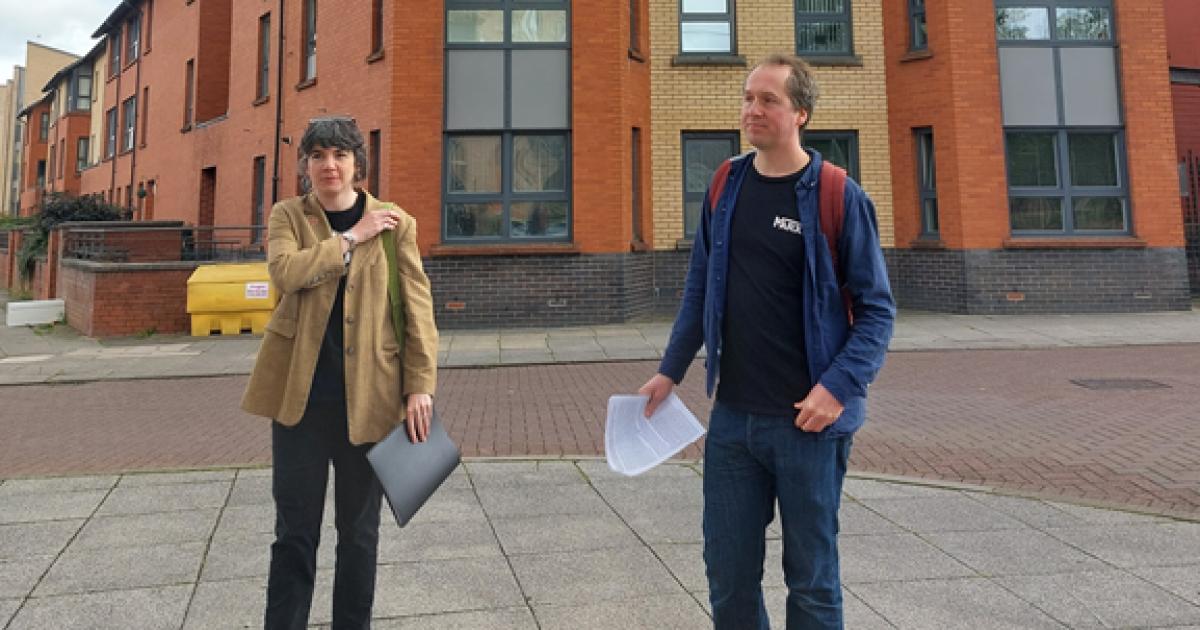This isn’t a standard history walk. Run by Mackinnon, Bell and David Lees, Radical Glasgow Tours create interactive walking tours that trace the city’s radical past — histories of activism, protest, and social change that are often hidden in plain sight. They operate on a pay-what-you-can basis, making the tours accessible to all, and also provide online resources, from audio tours to handouts on anti-fascism.
As we move through the Gorbals, the guides’ conversational style makes the history feel immediate and approachable. They hand round old photographs, switch seamlessly between speakers, and strike a balance of seriousness and humour. The stories they share feel tangible and alive, rooted not just in archives but in the streets around us.
Read more:
Some of the most memorable stops are where the surreal and the political intertwine. At the Southern Necropolis, we hear about the children who, in the 1950s, armed themselves with makeshift weapons to hunt the so-called “Gorbals Vampire.” Henry and Katherine describe the scene with energy: the smoke and dark atmosphere of the graveyard, the Gorbals illuminated by the Dixon Blazes, and the sense of a city both frightened and fascinated. The tale gripped the press, who blamed American horror comics for introducing young, impressionable Glaswegian children to perverse stories.
(Image: Miriam Ali)
The media-storm eventually reached the House of Commons, where, following a heated debate, the Children and Young Persons (Harmful Publications) Act 1955 was passed. The Act specifically banned the sale to minors of publications portraying ‘incidents of a repulsive or horrible nature’. The story could have been throwaway, but the guides connect it seamlessly to wider themes of community, moral panic, and the politics of fear.
Later, standing in the Southern Necropolis among the graves, Henry gestures towards the headstone of Thomas Lipton, the grocer who built his empire on tea. His commentary links Glasgow’s commercial success directly to empire: “becoming rich on a commodity that was extracted with great violence, subjugation, and colonialism.” It’s a powerful moment — a reminder of how even seemingly everyday comforts carry histories of exploitation.
The scope is broad: from anti-colonial Glasgow to queer histories, from Red Clydeside to refugee experiences. Each walk is different, but all share the same purpose: to highlight the people and communities who resisted oppression, organised, and reimagined society.
And it isn’t only the guides who shape the walk. I sat down to speak to Katherine after the tour ended. Our final stop was the Gorbals rose garden, where we took a seat after our two-hour walk. Looking out across the greenery Katherine notes: “People are just fascinated by Glasgow and the history of Glasgow, so if they get wind that you’re talking about Glasgow histories you get people jumping in…but it’s never been malicious in my experience, it’s always been quite supportive.”
That sense of civic pride runs through the tours. Katherine, reflecting on how locals often respond, points out that she has noticed how Glaswegians carry a certain sense of pride for the city, regardless of whether their families have been here for generations or if they’ve only just arrived.
The stories we hear are both global and local. Emma Goldman speaking to garment workers in the Gorbals. Irish radicals smuggling munitions across the city during the Easter Rising. Teenagers chasing vampires in graveyards. These aren’t dry textbook accounts — they are vivid, human, sometimes surreal tales that link Glasgow to international struggles of resistance and solidarity. At one point, as we stand among the unmarked graves of Glasgow’s labour workers at the Gorbals rose garden, Henry reflects: “[it’s an] ongoing fight and a reminder of the need for unity in the fight against fascism.” That urgency, linking past and present, gives the tours a quiet intensity.
For me, the tour challenged my preconceptions of Glasgow’s past. Growing up here, I thought I knew the city’s stories, but I realised how much had been left out of the mainstream narrative. Walking those streets, with layers of history unfolding before us, felt like seeing the Gorbals for the first time.
The Radical Glasgow Tour group are not about scaling up into a polished heritage industry. Katherine describes their ethos as open and collaborative: “We are one wee group of pals with a certain series of interests, but there are so many other stories and communities and histories that could use this as a way of sharing those histories, documenting them a wee bit, maybe getting those stories out to a wider audience.”
She adds that they actively encourage others to take inspiration: “What we’ve done is more like collaborative projects…rather than thinking of how we can work with somebody to create a tour, how can we upskill folk to do their own tours? The idea then would be to weave the community or the group with their own tour that they can then run themselves.”
Part of that vision is creating more self-led experiences. “We’re interested in doing more self-led tours with audio clips and those were developed collaboratively with community organisations. I think that is a way as well of making histories and the experience of moving through a space accessible to people in a different way…I think that’s something as well that, having different voices and collaborators can make it a really powerful experience.”
By the time we finish the tour, this part of the city feels different. What once looked like empty streets, pubs, and demolition sites now carry a rich history. Radical Glasgow Tours make the radical past impossible to ignore in the present — and they invite all of us to keep telling those stories.
To book a tour or get in touch, go to https://radicalglasgowtours.com/
